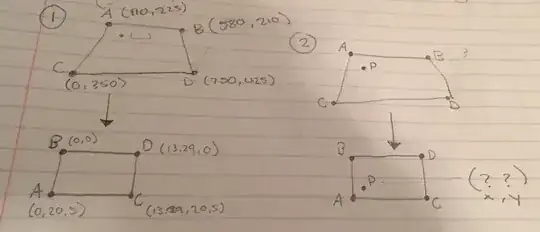Nonsingular affine (and linear) transformations preserve parallelism, so unless your quadrilateral is a paralellogram, there’s no affine transformation that will map it into a rectangle. On the other hand, every pair of convex quadrilaterals is related by a planar perspective transformation and, given that this is for a CS project, that’s likely what you’re meant to be using. You’ll need to work in homogeneous coordinates to do this, of course.
There’s a built-in function to compute this transformation in most decent computer graphic libraries, but if you need to work it out for yourself, there’s a nice description of how to compute this transformation here. Following that method, solving $$\begin{bmatrix}110&580&0\\225&210&350\\1&1&1\end{bmatrix} \begin{bmatrix}\lambda\\\mu\\\tau\end{bmatrix} = \begin{bmatrix}750\\425\\1\end{bmatrix}$$ and scaling by the result gives $$A=\begin{bmatrix}-286.077 & 1036.077 & 0.0 \\ -585.158 & 375.131 & 635.026 \\ -2.6007 & 1.7863 & 1.8144 \end{bmatrix}.$$ A similar computation for the destination rectangle produces $$B = \begin{bmatrix} 0.0 & 0.0 & 13.29 \\ -20.5 & 0.0 & 20.5 \\ -1.0 & 1.0 & 1.0 \end{bmatrix}$$ and so the required projective transformation is (approximately) $$H = BA^{-1} = \begin{bmatrix} 0.00192 & 0.0603 & -13.78 \\ -0.01636 & 0.01293 & 6.772 \\ 0.0004275 & 0.001709 & -0.04713 \end{bmatrix}.$$ (If you like, you can rescale this matrix without affecting the transformation that it produces by dividing through by the lower-right element to make it $1$.) I encourage you to work this out for yourself and verify that the vertices are mapped as desired. You can then use this matrix to map any other point in the source to the destination.
This transformation is not affine, of course, but as I mentioned in my comment to your question, we can pretend that we’re working in $\mathbb R^3$ instead of the projective plane $\mathbb{RP}^2$ and treat this as it it were a linear transformation, but instead of transforming points to other points, we’re transforming lines through the origin to other lines through the origin.
